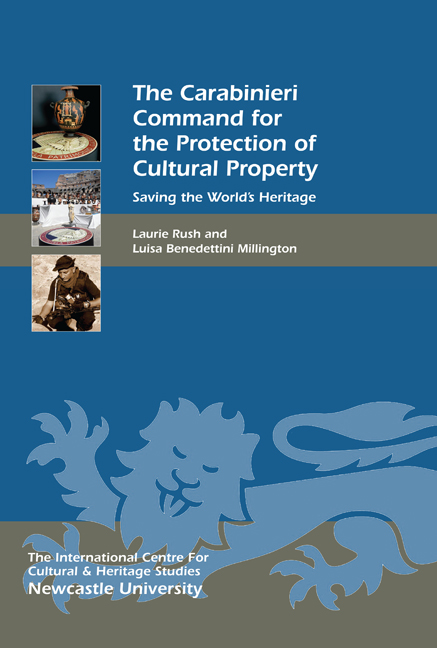Book contents
- Frontmatter
- Contents
- List of Illustrations
- Acknowledgments
- Foreword (in English and in Italian): Brigadier General Mariano Mossa
- Prefazione
- Abbreviations
- 1 The Carabinieri TPC: an Introduction and Brief History. Perché l’Italia? Why Italy?
- 2 Headquarters, the Databank and Operative Department in Rome
- 3 Carabinieri Public Outreach and Education
- 4 Central Italy and the Adriatic: Lazio, Florence, Bologna and Ancona
- 5 Activities in the North: Genova, Monza, Torino and Venezia
- 6 The Regional Offices: Naples, Bari and the South
- 7 The Challenges of the Island Regions: Sicily, Sardinia and the Palermo, Siracusa and Sassari Nuclei
- 8 Investigation Techniques
- 9 Repatriation of Works of Art to Italy: From Siviero to the Medici Conspiracy
- 10 Fakes, Forgeries and Money Laundering
- 11 Who Are the Officers of the Carabinieri TPC?
- 12 The Carabinieri, Peacekeeping and Foreign Relations: The Carabinieri Mission to Iraq
- 13 ‘The Italian Model’
- Bibliography and References
- About the Authors
- Index
- Heritage Matters
10 - Fakes, Forgeries and Money Laundering
Published online by Cambridge University Press: 21 May 2021
- Frontmatter
- Contents
- List of Illustrations
- Acknowledgments
- Foreword (in English and in Italian): Brigadier General Mariano Mossa
- Prefazione
- Abbreviations
- 1 The Carabinieri TPC: an Introduction and Brief History. Perché l’Italia? Why Italy?
- 2 Headquarters, the Databank and Operative Department in Rome
- 3 Carabinieri Public Outreach and Education
- 4 Central Italy and the Adriatic: Lazio, Florence, Bologna and Ancona
- 5 Activities in the North: Genova, Monza, Torino and Venezia
- 6 The Regional Offices: Naples, Bari and the South
- 7 The Challenges of the Island Regions: Sicily, Sardinia and the Palermo, Siracusa and Sassari Nuclei
- 8 Investigation Techniques
- 9 Repatriation of Works of Art to Italy: From Siviero to the Medici Conspiracy
- 10 Fakes, Forgeries and Money Laundering
- 11 Who Are the Officers of the Carabinieri TPC?
- 12 The Carabinieri, Peacekeeping and Foreign Relations: The Carabinieri Mission to Iraq
- 13 ‘The Italian Model’
- Bibliography and References
- About the Authors
- Index
- Heritage Matters
Summary
FORGERY IN ITALIAN CULTURE AND SOCIETY
There is no doubt about the importance of art in Italian society or the fact that this cultural value dates back hundreds, if not thousands, of years. Most agree that Italian artists have been among the greatest contributors to Western civilisation. This combination of values has also generated a subculture and tradition of forgery. Some forgers are talented artists in their own right and it is not unusual for Italians to figure among the best. Discussions of the history of forgery in Italy often begin with ancient Roman emulation of Greek sculpture (Fleming 1975, 6). The Romans considered Greek sculpture to be superior, so Roman sculptors worked to copy the style and figures of the Greeks. These activities might not have been considered forgery at the time but appear to be considered by scholars of forgery as one of the first examples of, at the very least, ‘imitation’ in the Western world. Phaedrus, the fabulist, wrote poetry that included accounts of forgery of silver coinage across the Roman Empire during the reign of Augustus, and there exists archaeological evidence of counterfeiting in Britain under the Romans (Fleming 1975, 6). According to Fleming (1975, 14), the year 1524 marks the first literary documentation of a forgery among paintings. An author named Pietro Summonte described the activities of a Neapolitan artist named Niccolò Antonio Colantonio who, 70 years earlier, was said to have copied a portrait of the Duke of Burgundy so successfully that when the copy was returned in place of the original, the owner did not notice.
It was not until 1735 that a European country, England, issued the very first example of copyright laws – then limited to engraved art (Engraving Copyright Act ). Up until that point, counterfeiters had not faced any criminal convictions and the worst that could happen to them was to fall from grace and lose the ‘protection’ of their patrons (Andros 2014).
Following the adoption of these and subsequent laws over the next 200 years, the counterfeiter has come to be seen no longer as an artist with valid talent and skills, but rather as a criminal. In Italy the falsification of artworks was not addressed by specific laws until 1939 and counterfeiters were still condemned under the ‘Counterfeiting of Private Writing’ article of the criminal code.
- Type
- Chapter
- Information
- The Carabinieri Command for the Protection of Cultural PropertySaving the World's Heritage, pp. 141 - 152Publisher: Boydell & BrewerPrint publication year: 2015



